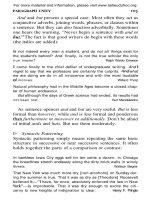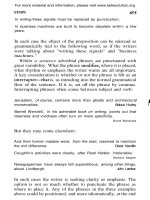Essential guide to writing part 26
Bạn đang xem bản rút gọn của tài liệu. Xem và tải ngay bản đầy đủ của tài liệu tại đây (275.29 KB, 15 trang )
PUNCTUATION
Paratactic compound sentences punctuated with semico-
lons are especially common when the second clause repeats
the first:
The New Deal was a new beginning; it was a new era of American
government. Arthur M. Schlesinger, Jr.
Wendell Willkie was publicly and privately the same man; he was
himself.
All of these and under some de-
gree of they were bound servants for greater or lesser
terms. Oscar Handlin
Using and in such sentences would be subtly misleading, im-
plying a change of thought where none in fact exists.
Parataxis is also effective between clauses expressing a sharp
contrast of idea:
Languages are not invented; they grow with our need for
expression. Susanne K. Langer
He [President Calvin Coolidge] knew precisely what the law was;
he did not concern himself with what the law ought to be.
Irving Stone
Groups are capable of being as moral and intelligent as the indi-
viduals who form them; a crowd is chaotic, has no purpose of its
own and is capable of anything except intelligent action and real-
istic thinking. Aldous Huxley
Clauses like these could be joined by a comma and but. Omit-
ting the conjunction and using a semicolon, however, makes
a stronger statement, forcing readers to see the contrast for
themselves.
Occasionally even coordinated clauses are separated by a
semicolon. This is done at the discretion of the writer and is
more common when the clauses are relatively long and com-
plicated, containing commas within themselves. In that case
a semicolon more clearly signals the break between them. The
For more material and information, please visit www.tailieuduhoc.org
STOPS
following sentence is an example (the Duke of Wellington is
commenting with pleasant cynicism upon the capacity of
young ladies to endure the absence of lovers gone to war):
They contrive, in some manner, to live, and look tolerably well,
notwithstanding their despair and the continued absence of their
lover; and some have even been known to recover so far as to be
inclined to take another lover, if the absence of the first has lasted
too long.
Even when the coordinated clauses are not very long, a
semicolon may still replace the more conventional comma if
the writer wants a pause for emphasis or rhythm:
Children played about her; and she sang as she worked.
Rupert Brooke
So the silence appeared like Death; and now she had death in her
heart. Ford Madox Ford
Run-on Sentences
A run-on sentence occurs when a semicolon has been omitted
between uncoordinated independent clauses. Sometimes a
comma is used instead (when it is, the error is often called a
"comma fault"):
INCORRECT It was late, we went home.1
And sometimes the clauses are simply run together with no
stop of any kind:
INCORRECT It was late we went home.
The most frequent cause of run-on sentences is mistaking
the function of conjunctive words as however,
1. Commas are sometimes effective in such cases, the so-called comma link.
Comma links are discussed on pages 286-87.
For more material and information, please visit www.tailieuduhoc.org
PUNCTUATION
therefore, consequently, even so, on the other
hand, for example. These adverbs do not join clauses gram-
matically; they only show a relationship between the ideas in
the clauses. In this they differ from coordinating conjunc-
tions, which traditionally designate both a grammatical and a
logical connection.
The difference may seem arbitrary. The coordinating con-
junction but and the conjunctive adverb however, for in-
stance, can be used almost interchangeably between appro-
priate clauses. Even so, the first is a conjunction and needs
only a comma (or maybe even no stop at all); the second is
an adverb and, when it is unaccompanied by a conjunction,
requires a semicolon:
It was not late, but we went home.
It was not late; however, we went home.
It would result in a run-on sentence to punctuate it like this:
INCORRECT It was late, however, we went home.
Run-on sentences may be corrected in several ways, though
for any given case one way will probably be best. The simplest
solution is to put a semicolon in the proper place. Or the
clauses may be joined by an appropriate coordinating con-
junction accompanied by a comma (though this stop may be
omitted if the clauses are short and simple). Or the two
clauses may be recast as two sentences. Finally, the clauses
may be kept as parts of the same sentence with one being
subordinated to the other, in which case a comma may or
may not be needed between them. Thus the run-on sentence
"The search was fruitless, the men were discouraged" can be
corrected:
The search was fruitless; the men discouraged.
The search was fruitless; and the men were discouraged.
For more material and information, please visit www.tailieuduhoc.org
STOPS 393
The search was fruitless. The men were discouraged.
Because the search was fruitless the men were discouraged.
Semicolon in Lists and Series
Semicolons are conventionally used to separate all the items
in a list or series when any of the items contains a comma.
This is done because the presence of a comma within one or
more items requires a stronger stop to signal the distinction
between one unit in the series and another. Look at this sen-
tence about the rise of the Ku in the 1920s:
There were other factors too: the deadly tedium of small-town life,
where any change was a relief; the nature of current Protestant
theology, rooted in Fundamentalism and hot with bigotry; and, not
least, a native American moralistic blood lust that is half historical
determinism, and half Freud. Robert Coughlan
Even when a comma occurs in only one item, consistency
requires that semicolons be used between all the elements of
the series:
He [Huey Long] damned and insulted Bigness in all its Louisiana
manifestations: Standard Oil, the state's dominant and frequently
domineering industry; the big corporations; the corporation
lawyers. Hodding Carter
Semicolon with Subordinate Clause
Now and then a semicolon separates a main clause and a sub-
ordinate one, a job conventionally assigned to the comma.
The stronger semicolon is helpful when the clauses contain
internal commas; it more clearly signals the break between
the clauses and helps the reader to follow the grammar:
He [the white policeman) moves through Harlem, therefore, like
an occupying soldier in a bitterly hostile country; which is precisely
For more material and information, please visit www.tailieuduhoc.org
394 PUNCTUATION
what, and where, he is, and is the reason he walks in twos and
threes. James Baldwin
SEMICOLON
Between independent clauses
A. Paratactic: semicolon is the conventional stop
B. Coordinated: comma is conventional
semicolon is optional for clarity or emphasis
II. In lists and series
Semicolon between all items when any item contains a comma
The Comma
The comma is the most frequent and the most complicated
of all marks of punctuation. It is least reducible to rule and
most subject to variation, depending on the need to be clear
or emphatic, the preferences of individual writers, and even
fashion.
Coordinated Independent Clauses
Coordinated elements are grammatically identical construc-
tions in the same sentence joined by a coordinating conjunc-
tion (and, but, for, or, nor, and the correlatives or,
nor, both ... and, not but). Any part of a
sentence may be coordinated: two subjects, two verbs, two
objects, two adjectivals, two adverbials, two independent
clauses.
As a very general rule, two coordinated independent
clauses are punctuated with a comma; lesser elements, such as
words, phrases, and dependent clauses, are not so punctuated.
But exceptions occur, depending on the length and complex-
ity of the constructions. Let's look at several examples.
Two coordinated independent clauses are usually separated
by a comma, placed immediately before the conjunction:
For more material and information, please visit www.tailieuduhoc.org
STOPS 395
It [history] is a story that cannot be told in dry lines, and its meaning
cannot be conveyed in a species of geometry. Herbert
When such coordinated clauses are complicated and contain
internal commas, the stronger semicolon may be used to sep-
arate them, as we saw on page 282. On the other hand when
they are short, obviously related, and contain no internal
commas, the comma between them may be omitted:
They tried to hold him up against the wall but he sat down in a
puddle of water. Ernest Hemingway
The Comma Link
A comma link is a comma used between independent clauses
that are is, not joined by one of the coordi-
nating conjunctions but simply run together. The semicolon
is the conventional mark in such a construction (see pages
282-83), and employing a comma is generally regarded as a
fault. Under certain circumstances, however, a comma may
be used between paratactic clauses (though it is never oblig-
atory). The clauses must be short and simple and contain no
internal stops; the relationship of ideas should be immediately
clear; and the sentences should move rapidly with only light
pauses:
A memoir is history, it is based on evidence. E. M. Forster
The crisis was past, the prospects were favorable.
Samuel Hopkins Adams
When three or more such short, obviously related inde-
pendent clauses are joined paratactically, comma links are
even more frequent:
Some of the people said that the elephant had gone in one direc-
tion, some said that he had gone in another, some professed not
even to have heard of any elephant. George Orwell
For more material and information, please visit www.tailieuduhoc.org









